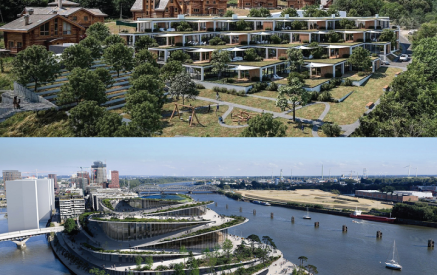The Armenian Weekly. Some say that if one looks long and hard enough the Edelweiss can be found up high in the remote mountains of Nagorno Karabakh, also known as Artsakh.
In German, the Edelweiss alpine flower means “noble” and “white.” Some refer to it as “dream flower,” while others, “noble purity.” It is a flower that, among other things, symbolizes “unusual daring,” and that its deep, deep, roots cannot be pulled or yanked from the depths of its jagged mountain bed. So, too, are the roots of the Armenians of Artsakh.
It was the Artsakh-born writer Davit Mnatsagan, author of the book, Aryootsamageelner, who, as a teenager, would search the mountains of Artsakh for the elusive Edelweiss. It was this rugged yet lovely flower that inspired the title of his book—a story of an Armenian poet and soldier, and his contemporaries—300 heroic young men, teenagers, who had formed a unit to defend their homeland. The author likened them to the Edelweiss. The story unfolds in the spring of 1804. “Ays ankam el garoonuh hayeree yergreen er yegel veeravor trchoonee nman… (This time too spring had come to the Armenians’ world like a wounded bird…).”
Artsakh is a tiny region in the world that has been inhabited by Armenians for thousands of years. Its name stems from the time of ancient Armenia. Artsakh was a part of Armenia, as was Nakhichevan. In Armenian, Nakhichevan means “place of descent,” and the “biblical reference to the descent of Noah’s Ark.” Unfortunately, both were “given” to Azerbaijan by Stalin, at which time Artsakh became an autonomous province of the Soviet Socialist Republic of Azerbaijan. Interestingly, “On 30 November 1920, the Azerbaijani Revolutionary Committee announced that it recognized the territories previously laid claim to by Azerbaijan—Nagorno Karabakh, Zangezur (Syunik, Armenia), and Nakhichevan—as inseparable parts of Armenia. Moreover, a written decree made by the Azerbaijani SSR National Council on 12 June 1921 declared that Nagorno Karabakh was an inseparable part of Armenian SSR.”
Read also
Shortly after, Azerbaijan renounced the November 30, 1920 statement. The following summer, however, the Caucasian Bureau of the Russian Communist Party officially announced that Nagorno Karabakh was indeed a part of the Soviet Socialist Republic of Armenia. The decision, however, was reversed by Stalin. As a result, under Azerbaijani subjugation, the Armenians of Artsakh suffered and continue to suffer atrocities at the hands of Azerbaijan.
Throughout the centuries, Artsakh has been attacked by various invaders—the Seljuk Turks, Tatar-Mongols, Ottoman Turks and others. In 1920, Shushi was attacked, destroyed and its Armenian population massacred by Azeri and Turkish forces. One hundred years later, the same is being attempted.
The clergyman Yesayi H. Jalalyan, who had been “among the main commanders in the history of the armed forces of Artsakh’s Khachaghakaberd (Armenian, meaning Magpie Fortress, built in the 8th century),” had witnessed and experienced how slowly, surreptitiously, the Azeris had slipped into Artsakh. He wrote, “Productive is our country. Courageous and patriotic are its children. Simply, our enemies are many. They are many and deceitful. Being sly snakes, they creep into our country, increasing our troubles and depriving us of our abilities.”
On September 27, 2020, Azerbaijani forces attacked the peaceful and unsuspecting population of Artsakh. Once again, the Artsakh Armenians’ battle for life, liberty and their ancestral homeland resumes, this time in the midst of a worldwide pandemic. The fight for Artsakh’s survival, however, is not only on the battlefield. It is also in the books written by historical revisionists. Since the 1950s, according to historical and anthropological sources, the Azerbaijani academics have been “renaming prominent medieval Armenian political leaders, historians and writers, who lived in Nagorno Karabakh and Armenia into Albanians (Caucasian Albanians)” by “ripping the population of early medieval Nagorno Karabakh off from their Armenian heritage,” and “cleansing Azerbaijan of Armenian history.” They have also been involved in falsely characterizing Azerbaijani culture by stating that “Caucasian Albanians” were the “ancestors of modern Azerbaijanis.” Another example of historical revisionism by Azerbaijan is that the term “Armenian state” has been removed and replaced with “Albanian state.” One Azerbaijani source has even relocated Caucasian Albania into what is the Republic of Armenia. Armenian khachkars (cross stones) are described as “monuments of Caucasian Albania” and not that of Armenia. Armenian khachkars and gravesites in Nakhichevan have been destroyed by Azerbaijan in order to prove that Armenians never lived on that land. Clearly, the aim of Azerbaijan, once and for all, is the “ethnic cleansing of the Armenian people.”
The Montevideo Convention on the “Rights and Duties of States” outlines the “four criteria for statehood.” They are:
- A defined territory.
- A permanent population.
- A government.
- The capacity to enter into relations with other states.
“…The first sentence of Article 3 explicitly states that ‘The political existence of the state is independent of recognition by the other states.’”
Having fulfilled the criteria for statehood as outlined in the Montevideo Convention, Nagorno Karabakh proclaimed its independence on December 10, 1991 after an arduous battle for freedom lasting over six years. It became known as the Republic of Artsakh. It is a presidential democracy with its own flag, national anthem, coat of arms, military, currency and a population that is 99.7 percent Armenian. Its primary language is Armenian.
Why, then, has Artsakh’s independence not been recognized? Why is there silence as the world witnesses the murder of the Armenian people of Artsakh and the destruction of their ancient homeland?
In the words of the Armenian author Khachatur Abovian: “If the Armenian Nation were a mountain, it would have crumbled. If it were iron, it would have melted. If it were a sea, it would have dried up, but the God-loving Armenian Nation stood up to all these and kept its identity.”
References:
“Brief History of Artsakh (Nagorno Karabakh),” “MIA” Publishers, Yerevan, Republic of Armenia, 2013.
Aryootsamageelner, Knarik O. Meneshian.
Knarik O. Meneshian
Caption: Edelweiss (Photo: Flickr/bulbocode909)

























































